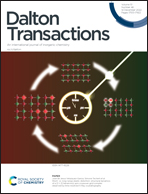CO2 capture from ambient air via crystallization with tetraalkylammonium hydroxides†
Abstract
Aqueous solutions of a series of short carbon chain tetra(n-alkyl)ammonium hydroxides, [Nnnnn][OH] with n = 2: n-ethyl, 3: n-propyl, 4: n-butyl, have been serendipitously found to be potential candidates for direct air carbon capture (DAC) when being used as reagents in more complicated reactions. Aqueous solutions of [N3333][OH], [N2222][OH], or [N3333][OH] with UO2SO4·3H2O and 1,4-diamidoximylbenzene, and [N4444][OH] with cytosine (HCyt) directly absorb CO2 from the atmosphere upon mild heating in the open atmosphere crystallizing in complexes reaching up to 2 : 1 CO2/[Nnnnn]OH ratio. [N2222][HCO3]·3H2O (1), [N2222]2[H(HCO3)3]·5H2O (2), [N3333][HCO3]·0.5H2O (3), [N3333][H(HCO3)2] (4), [N3333]2[(tpa)(H2CO3)2] (5; tpa = terephthalate), [N4444][H(Cyt)(HCO3)]·H2O (6) and [N4444][H2(Cyt)2(HCO3)]·H2O (7) have been isolated in crystalline form and structurally characterized by single crystal X-ray diffraction. The compounds are characterized by complex polyanionic formations from bicarbonate dimers ([(HCO3)2·(H2O)]24−) or chains ([H(HCO3)2]nn− or [H2(tpa)(HCO3)2]n2n−) to water-bicarbonate associates ([(HCO3)2·6H2O]2− and [(H2CO3·(HCO3)2)2·6H2O·2H2O]2−) and three-component anionic layers ([H(Cyt)(HCO3)·H2O]nn− and [H2(Cyt)2(HCO3)·H2O]nn−) frequently showing proton sharing. While some hydroxides themselves can maintain a high CO2/[Nnnnn][OH] ratio, particularly 2 and 4, the presence of secondary hydrogen bond donors/acceptors may increase the sorption efficiency through decreased solubility and enhanced crystallization.

- This article is part of the themed collections: Nordic Collection and Dalton Transactions up-and-coming articles


 Please wait while we load your content...
Please wait while we load your content...